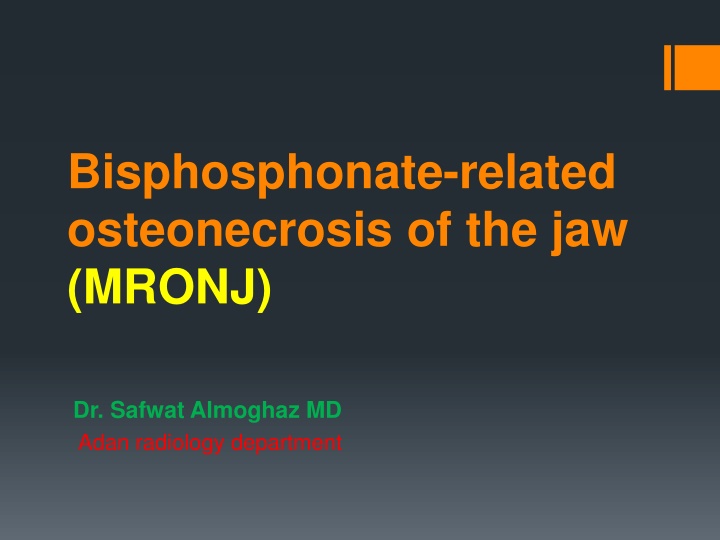
Bisphosphonate-Related Osteonecrosis of the Jaw (MRONJ) Radiological Findings
Explore the clinical case of a 60-year-old female with metastatic breast cancer and bisphosphonate therapy, presenting with mandibular pain and swelling. Radiological findings reveal osteolytic lesions in the mandible, indicative of Medication-Related Osteonecrosis of the Jaw (MRONJ). Learn about the importance of early recognition, management strategies including conservative and surgical interventions, and preventive measures in patients on bisphosphonate therapy to reduce the risk of MRONJ development.
Download Presentation

Please find below an Image/Link to download the presentation.
The content on the website is provided AS IS for your information and personal use only. It may not be sold, licensed, or shared on other websites without obtaining consent from the author. If you encounter any issues during the download, it is possible that the publisher has removed the file from their server.
You are allowed to download the files provided on this website for personal or commercial use, subject to the condition that they are used lawfully. All files are the property of their respective owners.
The content on the website is provided AS IS for your information and personal use only. It may not be sold, licensed, or shared on other websites without obtaining consent from the author.
E N D
Presentation Transcript
Bisphosphonate-related osteonecrosis of the jaw (MRONJ) Dr. Safwat Almoghaz MD Adan radiology department
Case synopsis and Final Diagnosis Clincal data: A 60-year-old female with a history of metastatic breast cancer to the bone, currently on hormonal therapy and bisphosphonate treatment, presented with ppain and swelling of the mandible. Radiological Findings: Initial CT Neck: No lesions identified in the mandibular region. Follow-up CT Neck: An osteolytic lesion observed in the right mandibular body with disruption of both inner and outer cortical plates. Presence of sequestrum within the lesion. Evidence of recent tooth extraction in the affected area, compared to the previous study. Associated soft tissue component noted. No additional suspicious lesions detected in the visualized osseous structures. Impression: Given the patient's history of bisphosphonate therapy and the radiological findings, MRONJ is the most likely diagnosis. Differential Diagnosis: Medication-related osteonecrosis of the jaw (MRONJ).(1) Metastatic disease. Osteomyelitis. Management and Treatment: Management includes conservative measures such as antimicrobial mouth rinses, systemic antibiotics, and pain control. Surgical intervention may be considered in advanced cases or if conservative treatment fails. Preventive strategies, including dental assessments prior to initiating bisphosphonate therapy and avoiding invasive dental procedures during treatment, are crucial to reduce the risk of developing MRONJ. (2) Conclusion: This case highlights the importance of monitoring for MRONJ in patients undergoing bisphosphonate therapy, especially following dental extractions. Early recognition and appropriate management are essential to prevent progression and improve patient outcomes.
CT Findings: Initial CT Neck: Initial CT Neck: No lesions identified in the mandibular region. Follow-up CT Neck: An osteolytic lesion is observed in the right mandibular body, accompanied by disruption of both inner and outer cortical plates. Presence of sequestrum within the lesion. Evidence of recent tooth extraction in the affected area, as compared to the previous study. Associated soft tissue component is noted. No additional suspicious lesions detected in the visualized osseous structures. Impression: The imaging features are suggestive of osteonecrosis of the jaw (ONJ), characterized by osteolysis, cortical disruption, sequestrum formation, and soft tissue involvement.(3) This case has been published on the Radiopaedia website. https://radiopaedia.org/cases/bisphosphon ate-related-osteonecrosis-of-the-jaw-2 Axial neck CT bone widow Follow-up CT Neck: Axial neck CT bone widow
References: 1. Morag Y, Morag-Hezroni M, Jamadar DA, Ward BB, Jacobson JA, Zwetchkenbaum SR, Helman J. Bisphosphonate-related osteonecrosis of the jaw: a pictorial review. Radiographics : a review publication of the Radiological Society of North America, Inc. 29 (7): 1971-84. doi:10.1148/rg.297095050 - Pubmed 2. Bisphosphonate-related osteonecrosis of the jaw: the Florence experience. A Borgioli, M Duvina, L Brancato, C Viviani, ML Brandi, and P Tonelli. Clin Cases Miner Bone Metab. 2007 Jan Apr; 4(1): 48 52. 3. P.M. Phal, R.W.T. Myall, L.A. Assael, J.L. Weissman. Imaging Findings of Bisphosphonate-Associated Osteonecrosis of the Jaws. American Journal of Neuroradiology. 28 (6): 1139. doi:10.3174/ajnr.A0518 - Pubmed
